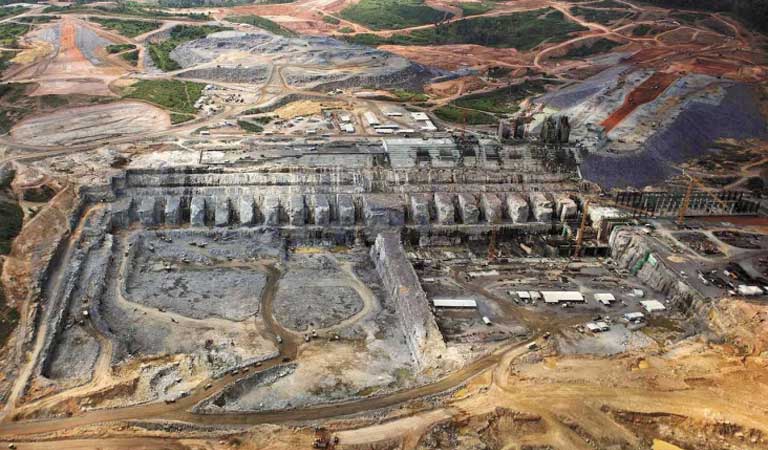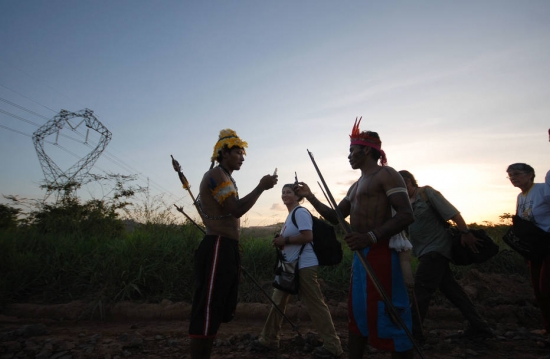Brazil’s BNDES is the largest development bank in the world. It’s enormous, poorly managed pay outs to Amazon dam projects have fuelled mass corruption.
Brazil’s BNDES (Banco Nacional de Desenvolvimento Econômico e Social) is the largest development bank in the world. Its annual disbursements of US$50 billion in 2014 were greater than those of the World Bank and Ex-Im Bank (Export-Import Bank of the United States) taken together. Although the bank has played a key role in Brazil’s development over the decades, its hasty expansion in recent years has created widespread concern that the bank is out of control and causing damage to Brazil’s people and biodiversity.
In the first of five articles on the BNDES, Sue Branford looks at how the bank has become embroiled in an Amazon development scheme in which an alliance of profit-hungry construction companies and unethical politicians is pressing ahead with a series of huge hydroelectric dams without considering whether those dams will make a real contribution to the region’s development, or what the cost will be to the environment and indigenous people.
Amassive corruption scandal, originally code named “Lava Jato” (Car Wash), erupted in Brazil in March 2014, and it is going on still. Police investigations have unearthed revelation after revelation, making it clear that the country’s largest company, the state-run oil giant Petrobrás, has been involved in bribery, bid rigging and kickbacks on a mind-boggling scale. Evidence is emerging of a vast money-laundering operation, likely totalling at least R$10 billion (US$3.5 billion).
The scandal is now rippling out beyond Petrobrás to the Amazon, where a small group of very large construction companies are building a series of gigantic hydroelectric dams. The Lava Jato investigation is now starting to explain one of the mysteries surrounding Amazon development: why the Brazilian government is investing so heavily in these dams, which have long been criticised for being economically unviable, and socially and environmentally unsustainable.

Puzzle pieces began falling into place in December 2014 when Paulo Roberto Costa, a former director of Petrobrás and one of the highest-ranking officials involved in the scandal, told Congress that corruption on a huge scale was occurring outside the oil sector. He disclosed that: “It [corruption] happens all over Brazil, with regard to highways, trains, ports, airports and hydroelectric dams. All you have to do it investigate.” Shortly, information began to surface that corruption had guided the awarding of the big Amazon dam contracts.
Corruption at foundation of Belo Monte dam?
In June 2015, Dalton Avancini, the former CEO of Camargo Corrêa, one of Brazil’s largest construction companies, testified to public prosecutors that his company had paid R$30 million (US$9.6 million) to the ruling Workers’ Party (PT) and the other main party in the ruling coalition, the PMDB, in exchange for contracts for the giant and controversial Belo Monte dam on the Xingu River in the Amazon.
It was soon reported that other big companies had also been involved in Amazon skulduggery. Some of Brazil’s biggest construction companies — Odebrecht, Andrade Gutierrez, OAS and Galvão Engenharia — were said to have paid bribes, just like Camargo Corrêa, to win Belo Monte contracts.
In the face of mounting evidence, Sérgio Ricardo Costa Caribé, from the MPF (Federal Public Ministry) — an independent branch of the federal government leading the investigations — asked Brazil’s TCU (Central Accounting Office) to set up an investigation to see “if the practices revealed by the Lava Jato operation are also occurring in state companies in the electricity sector.”

In September 2015, José Múcio Monteiro, the investigation’s TCU rapporteur, announced that he would concentrate his inquiries on the Belo Monte dam. He was doing this, he said, because it was “the country’s biggest, totally national hydroelectric power station” and involved the very large investment of R$33 billion (US$8.7 billion). Roughly two-thirds of that amount — RS$22.5 billion (US$6 billion) — had been contributed by the BNDES, which meant that Brazilian taxpayers were footing most of the bill for construction and alleged corruption.
Although Monteiro has not yet published his report as yet, a mass of worrying information has emerged that suggests catastrophic flaws in the “political and economic architecture” of the project. It appears that Belo Monte was ill-conceived from the outset.
Prior to construction, studies had shown that, unless extreme care was taken, the dam would seriously harm not only the region’s rich biodiversity, but also the livelihoods and culture of local people, particularly indigenous groups. A recent independent federal investigation found that these dire forecasts have likely been fulfilled, with the chief Belo Monte construction company and the Brazilian federal government now accused of ethnocide against seven indigenous groups.
Engineering studies had also predicted before construction that water levels in the reservoirs would be so low that the dam would not generate enough energy to pay for itself. An authoritative 2015 study bears out these predictions, and worse: it found that the flow of the Xingu river in eastern Amazonia, which will feed the Belo Monte dam, will fall by 25 to 55 percent due to climate change by 2040 — potentially turning the giant dam into a useless white elephant.

Faced with these damning forecasts, the construction companies refused to put their own money into the project and withdrew from the Belo Monte consortium. But the companies were happy to bid for portions of the construction work, knowing that they would be paid, no matter how little energy the dam generated. In so doing, they transferred all financial risk to the government and state-run companies, and guaranteed their profits. The financing of Belo Monte by the BNDES left taxpayers holding the bag.
BNDES: the goose that lays the golden eggs
While evidence is still being uncovered, the central role that BNDES has played in the development of the vast new network of Amazon dams, and in Brazilian corruption schemes, is clear: If the bank had been more transparent and accountable during the planning stages, and had protected the public interest — as its statutes require — Belo Monte and other dams, such as Santo Antônio and Jirau on the Madeira River in western Amazonia, would not have gone ahead or would have been built in a very different, more modest and less damaging way.

The BNDES is important for another reason: it is the goose that lays the golden eggs. The bank is the channel through which billions of taxpayer dollars are transferred to the Amazon without proper controls or oversight — money which unscrupulous businessmen and politicians can easily get their hands on, with few questions asked.
Not surprisingly, the huge Brazilian construction companies, which benefit from BNDES investments and government contracts, have become key funders of politicians’ electoral campaigns. In return, the companies expect to be awarded over-priced projects, from which they skim enormous profits. According to a US academic study into campaign donations and government contracts in Brazil, corporate donors to the PT in the 2006 elections received between 14 to 39 times the value of their donations in government contracts.
While this kind of corruption exists in many countries, it appears to have spiraled out of control in Brazil, facilitated by the lack of independent supervision of powerful players, particularly the BNDES. Based on what is known, there is certainly evidence of over-billing for dams in the Amazon. Belo Monte’s budget, originally set at R$19 billion (US$5 billion), has increased to R$33 billion (US$8.75 billion). The two dams on the Madeira River also overran costs: Santo Antônio, originally budgeted at R$14.3 billion (US$3.8 billion), cost R$19.2 billion (US$5.1 billion); and Jirau, originally budgeted at R$9.6 billion (US$2.5 billion), cost R$16.6 billion (US$4.4 billion).
The BNDES has made decisive contributions to all these dams: R$22.5 billion (US$6.0 billion) to Belo Monte; R$6.1 billion (US$1.6 billion) to Santo Antônio; R$9.5 billion (US$2.5 billion) to Jirau in two investments R$7.2 billion (US$1.9 billion) in 2009 and an additional R$2.3 billion(US$0.6 billion) in 2012.
Where big money flows corruption goes

One of the people following the saga of the Amazonian dams closely is Felício Pontes, a MPF Prosecutor in the state of Pará. He told Mongabay: “The factor that explains the irrational option for hydroelectric stations in the Amazon is corruption. Many people classify corruption in Brazil as endemic but, in the case of the electric sector, it is much more serious and can even be considered a pandemic because of its widespread nature, the influence of the bribes in decision-making, and the predominance of private interests over the fundamental rights of Brazilian citizens. In other words, energy planning in Brazil is not treated as a strategic issue involving the future of the nation but, at least since the time of the military dictatorship, as a source of money for construction companies and politicians. I think that, until these questions are exposed and resolved, we will continue to have expensive and inefficient dams that have a serious social and environmental impact in Amazonia.”
The current corruption investigations continue gaining momentum. The huge construction company, Camargo Corrêa, has paid back R$700 million (US$175 million) to the public purse in recognition of its crimes, the biggest payment of its kind ever made in Brazil. Several chief executives of construction companies are under arrest. In December Marcelo Odebrecht, the grandson of the founder of Brazil’s largest construction firm — detained by authorities since June — resigned as president of the company.
Some action has also been taken to staunch the flood of corruption. The Supreme Court has now banned corporate donors from contributing to candidates or political parties, though it is too early to be sure that the new ruling will be effective.
Meanwhile, the corruption turmoil is adding to Brazil’s current economic woes, which have been largely driven by the decline in world commodity prices. The country’s GDP is estimated to have fallen by 3.2% in 2015.

Deltan Dallagnol, a public prosecutor in the MPF and head of the Lava Jato investigation, is confident that the upheaval is worth the strife, and that it has the potential to catalyse a big change in Brazilian political culture. He said in December 2015: “We need to understand that together we hold in our hands the power to change our country. Brazil isn’t the private property of a corrupt elite. The window for changing Brazil is open, and it is today that we decide what country we will have tomorrow”. The MPF is organising a petition to demand tougher measures to combat corruption. When it has gathered 1.5 million signatures, Congress will be required to debate the issue.
It is difficult to predict the long-term repercussions of the present investigations. With powerful economic interests at stake, and the Brazilian government in chaos, and with attempts by the opposition to impeach President Rousseff, it will not be easy to instigate lasting change. But, at the very least, the scandal has brought the past actions of unscrupulous officials and companies, and the BNDES into the light, and thrown them off balance for now. The investigation has also created space for a debate on how the huge sums invested by the BNDES should be spent and managed in future, a discussion many in Brazil say is long overdue.
– This report was originally published in Mongabay and is republished by an agreement to share content.




